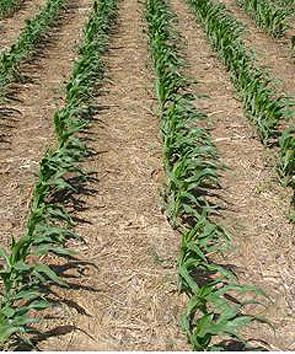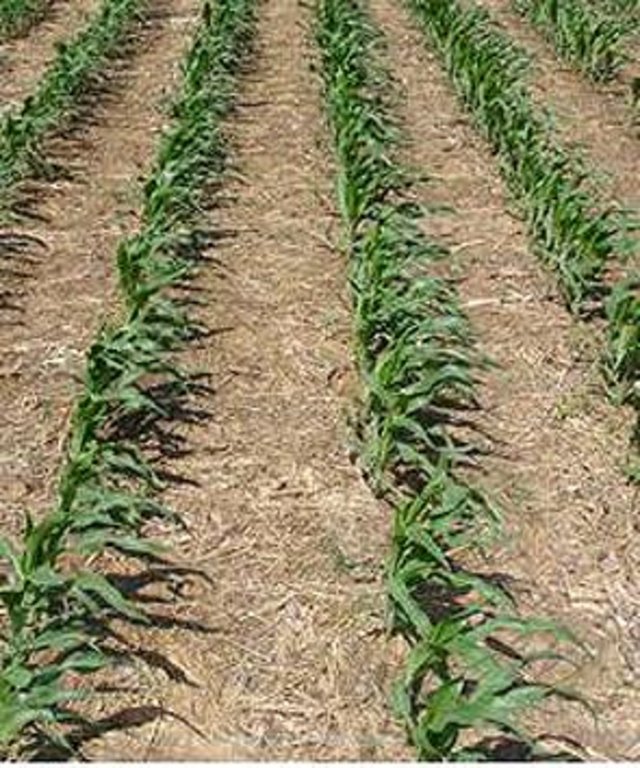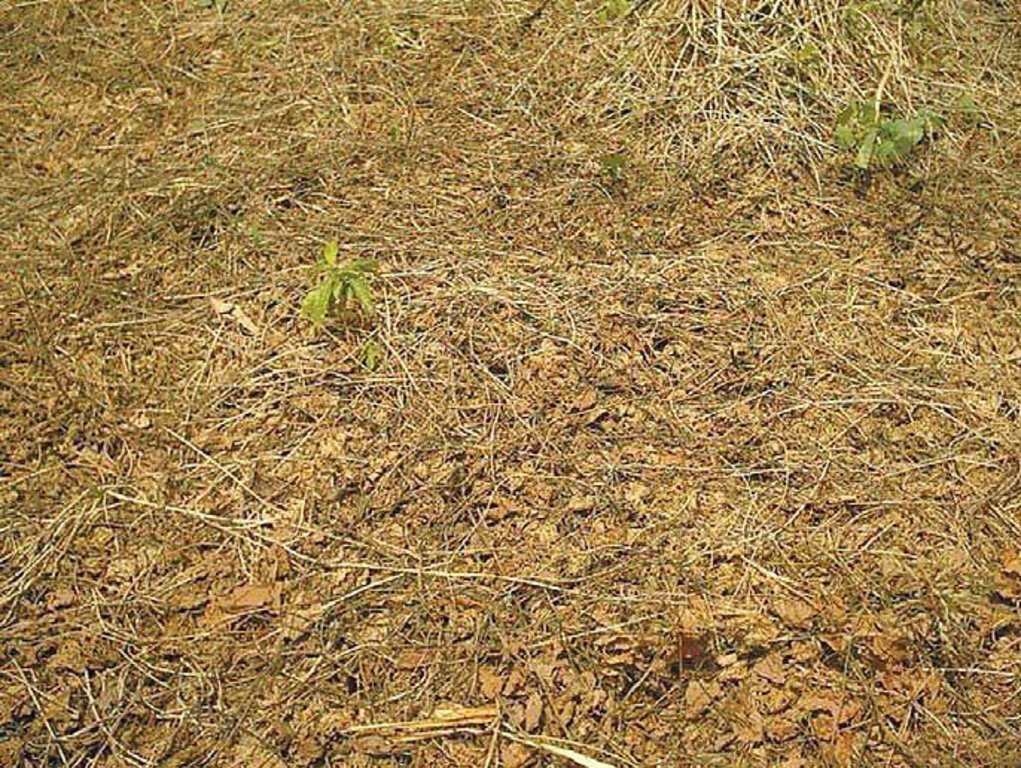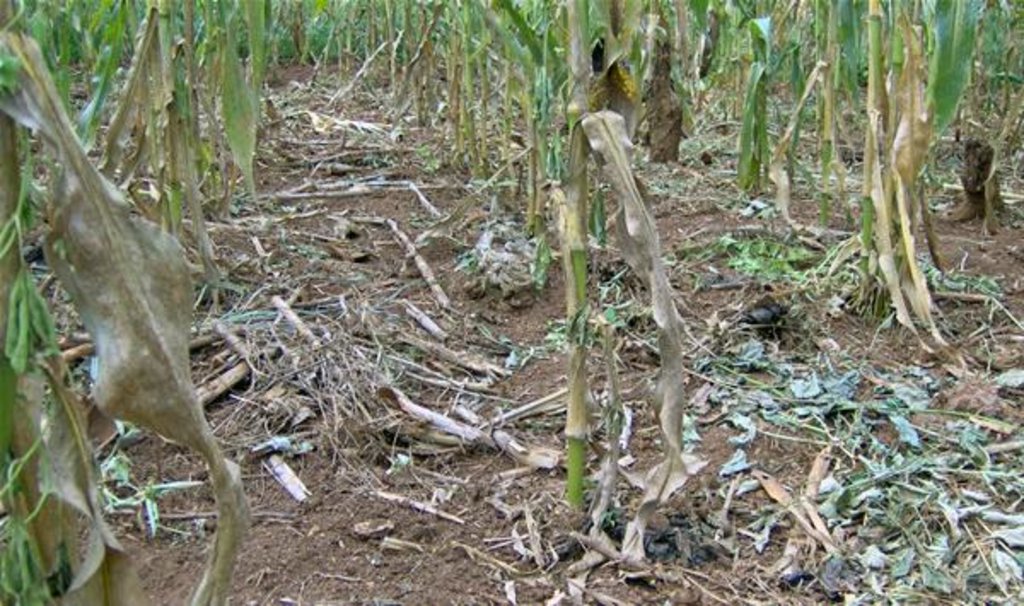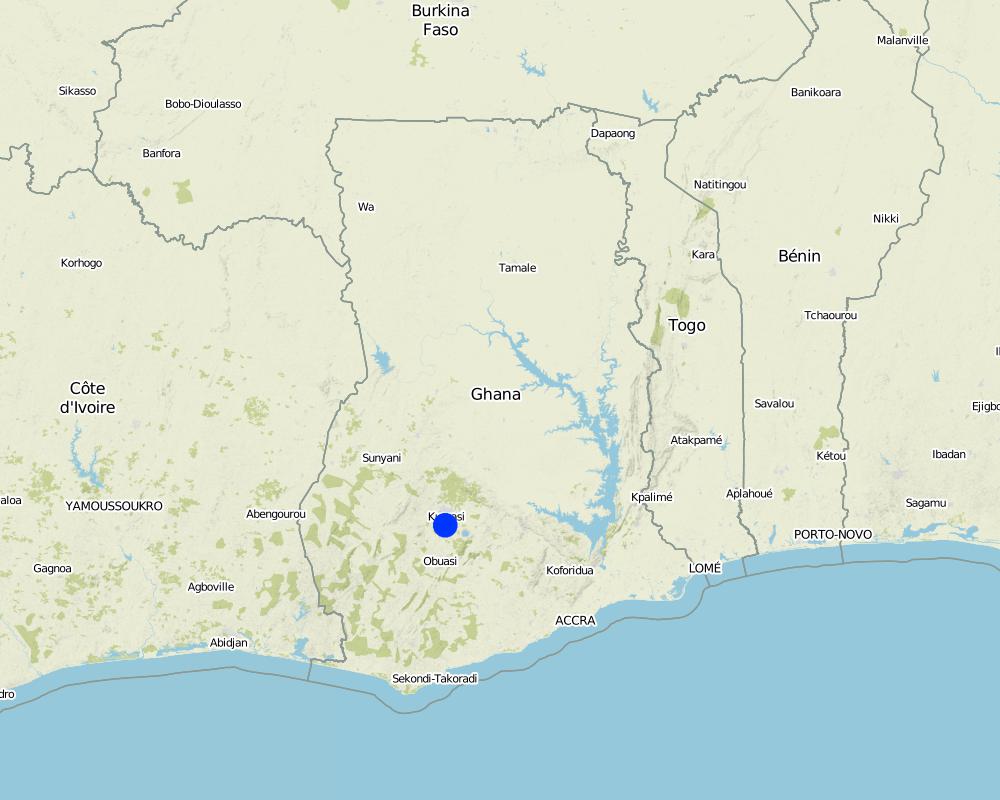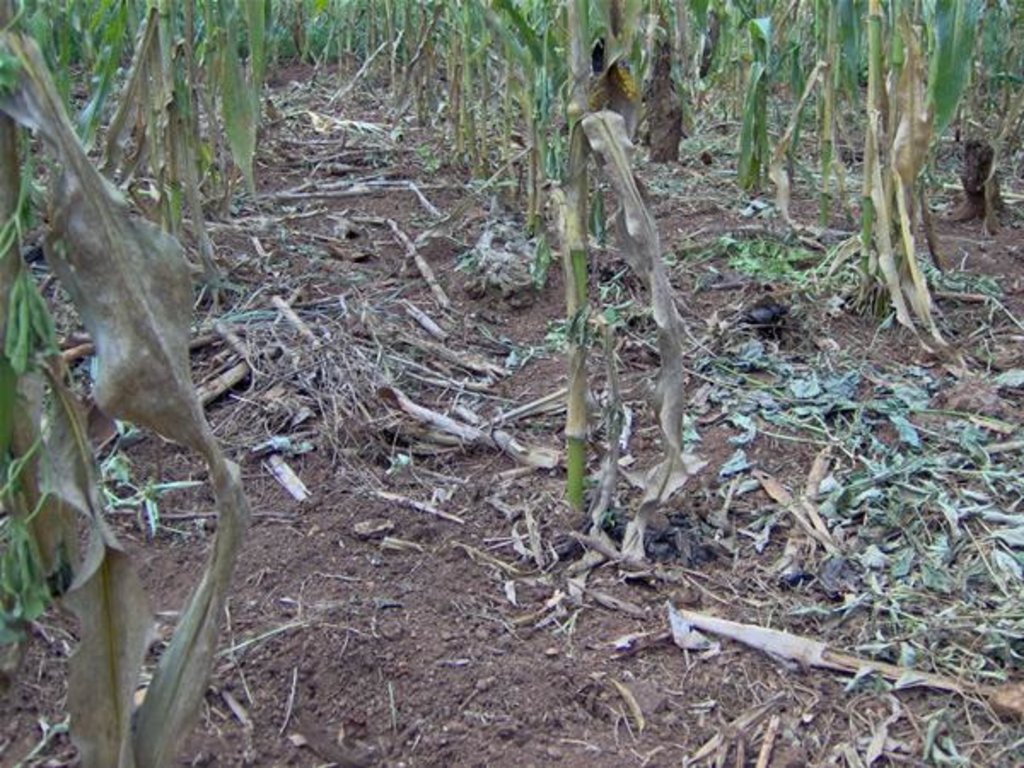Minimum Tillage and Direct Planting [Ghana]
- Creation:
- Update:
- Compiler: Unknown User
- Editor: –
- Reviewers: Fabian Ottiger, Alexandra Gavilano
technologies_1329 - Ghana
View sections
Expand all Collapse all1. General information
1.2 Contact details of resource persons and institutions involved in the assessment and documentation of the Technology
Key resource person(s)
SLM specialist:
Adjimon Souroudjaye
Volta Environmental Conservation Organization
Ghana
Name of project which facilitated the documentation/ evaluation of the Technology (if relevant)
Book project: SLM in Practice - Guidelines and Best Practices for Sub-Saharan Africa (SLM in Practice)1.3 Conditions regarding the use of data documented through WOCAT
The compiler and key resource person(s) accept the conditions regarding the use of data documented through WOCAT:
Yes
2. Description of the SLM Technology
2.1 Short description of the Technology
Definition of the Technology:
Minimum tillage and direct planting are two conservation agriculture practices which basically consist of leaving crop residues on the soil surface without burning and subsequent planting through the mulch.
2.2 Detailed description of the Technology
Description:
The traditional slash-and-burn land use system in the case study area – involving clearing natural vegetation followed by 2-5 years of cropping – has become unsustainable as land pressure has greatly increased, shortening fallow periods. Under the SLM practice of ‘minimum tillage and direct planting’, land is prepared by slashing the existing vegetation and allowing regrowth up to 30 cm height. A glyphosate-based round-up herbicide (Round-up, Chemosate or Helosate) is sprayed with a knapsack fitted with a low-volume nozzle. The residue is left on the soil surface without burning. After 7–10 days, direct planting is carried out in rows through the mulch. Maize is the main crop planted under this system. Planting is practiced manually using a planting stick.
Purpose of the Technology: The mulch layer has several important functions: it helps to increase and maintain water stored in the soil, reduces soil erosion, contributes to improve soil fertility (after crop residues have decomposed in subsequent seasons) and it efficiently controls weeds by hindering their growth and preventing weeds from producing seeds. The use of herbicides requires adequate knowledge. An even better option is to introduce multipurpose cover crops to control weed populations, improve soil fertility, and enhance yields while diversifying crop production and thus reducing dependence on the use of herbicides. Labour inputs for land preparation and weeding is considerably decreased under conservation agriculture. Women benefit most from the workload reduction since these time-consuming activities are their task. For men, the new technology usually means heavier work, especially during the 1st year, since they have to plant through the mulch. Using a jab planter makes the work easier
Establishment / maintenance activities and inputs: Minimum tillage and direct planting includes the following recurrent activities: 1. Initial land clearing: slash existing vegetation and allow regrowth (up to 30 cm); before onset of rains season.
2. Spraying of pre-emergence herbicide; 300 ml (2 sachets) for every 15 litres water for annual weeds; 450 ml (3 sachets) for every 15 litres water for perennial weeds.
3. Leave residues on the soil surface without burning.
4. Planting through the mulch.
5. Spraying post-emergence herbicide; after regrowth of weeds (7-10 days after planting).
6. Harvesting.
All activities are carried out manually (each cropping season) using jap planter (or a planting stick) and knapsack sprayers.
Natural / human environment: Both case study areas fall within the wet semi-equatorial zone of Ghana with a mean monthly temperature of between 23 °C and 33 °C (SDA 1995). Rainfall is bimodal in both districts with a peak rainy season from the end of March to July and again from September to November, after a short dry spell in August. In general soil characteristics in the study areas vary from well drained with high organic matter content in the forest area, to poorly drained with low organic matter content in the savannah belt.
2.3 Photos of the Technology
2.5 Country/ region/ locations where the Technology has been applied and which are covered by this assessment
Country:
Ghana
Region/ State/ Province:
Brong Ahafo Region
Further specification of location:
Sunyani and Atwima district
Map
×2.6 Date of implementation
If precise year is not known, indicate approximate date:
- 10-50 years ago
2.7 Introduction of the Technology
Specify how the Technology was introduced:
- during experiments/ research
Comments (type of project, etc.):
early 1990s
3. Classification of the SLM Technology
3.1 Main purpose(s) of the Technology
- improve production
- reduce, prevent, restore land degradation
- adapt to climate change/ extremes and its impacts
- create beneficial economic impact
3.2 Current land use type(s) where the Technology is applied

Cropland
- Annual cropping
Annual cropping - Specify crops:
- cereals - maize
Comments:
Major land use problems (land users’ perception): Fertility decline and reduced organic matter, water erosion, destruction of vegetation trough fires
3.5 SLM group to which the Technology belongs
- improved ground/ vegetation cover
- minimal soil disturbance
3.6 SLM measures comprising the Technology

agronomic measures
- A1: Vegetation/ soil cover

management measures
- M2: Change of management/ intensity level
Comments:
Main measures: agronomic measures
Secondary measures: management measures
3.7 Main types of land degradation addressed by the Technology

soil erosion by water
- Wt: loss of topsoil/ surface erosion

chemical soil deterioration
- Cn: fertility decline and reduced organic matter content (not caused by erosion)

biological degradation
- Bq: quantity/ biomass decline
- Bf: detrimental effects of fires
Comments:
Main type of degradation addressed: Wt: loss of topsoil / surface erosion, Cn: fertility decline and reduced organic matter content
Secondary types of degradation addressed: Bq: quantity / biomass decline, Bf: detrimental effects of fires
Main causes of degradation: soil management, population pressure, land tenure
3.8 Prevention, reduction, or restoration of land degradation
Specify the goal of the Technology with regard to land degradation:
- prevent land degradation
- reduce land degradation
4. Technical specifications, implementation activities, inputs, and costs
4.1 Technical drawing of the Technology
Technical specifications (related to technical drawing):
Residue management on a field with mature maize plants
Technical knowledge required for field staff / advisors: moderate
Technical knowledge required for land users: moderate
Main technical functions: control of raindrop splash, improvement of ground cover, increase in organic matter, increase in nutrient availability (supply, recycling,…), increase / maintain water stored in soil
Author:
Souroudjaye Adjimon, Volta Environmental Conservation Organization, Ghana
4.3 Establishment activities
| Activity | Timing (season) | |
|---|---|---|
| 1. | Purchase jab planter | |
| 2. | Purchase herbicides | |
| 3. | Purchase knapsack |
4.4 Costs and inputs needed for establishment
| Specify input | Unit | Quantity | Costs per Unit | Total costs per input | % of costs borne by land users | |
|---|---|---|---|---|---|---|
| Equipment | Tools | ha | 1.0 | 70.0 | 70.0 | 100.0 |
| Total costs for establishment of the Technology | 70.0 | |||||
| Total costs for establishment of the Technology in USD | 70.0 | |||||
Comments:
Remarks: Input costs include Jab planter US$ 20; herbicides US$ 5-6/liter. A knapsack costs US$ 50, which not affordable for small-scale farmers (they have to get organised in groups, or hire spraying gangs). Comparing to the traditional slash-and-burn system, Minimum tillage and direct planting has increased inputs costs but reduced labour costs and higher yields, which makes the conversion profitable!
4.5 Maintenance/ recurrent activities
| Activity | Timing/ frequency | |
|---|---|---|
| 1. | Initial land clearing: slash existing vegetation and allow regrowth (up to 30 cm) | before onset of rainy season |
| 2. | Spraying of pre-emergence herbicide; 300 ml (2 sachets) for every 15 litres water for annual weeds; 450 ml (3 sachets) for every 15 litres water for perennial weeds | |
| 3. | Leave residues on the soil surface without burning | |
| 4. | Planting through the mulch | |
| 5. | Spraying post-emergence herbicide; after regrowth of weeds | 7-10 days after planting |
4.6 Costs and inputs needed for maintenance/ recurrent activities (per year)
| Specify input | Unit | Quantity | Costs per Unit | Total costs per input | % of costs borne by land users | |
|---|---|---|---|---|---|---|
| Labour | Labour | ha | 1.0 | 83.0 | 83.0 | 100.0 |
| Equipment | Tools | ha | 1.0 | 18.0 | 18.0 | |
| Fertilizers and biocides | Herbicides | ha | 1.0 | 110.0 | 110.0 | |
| Total costs for maintenance of the Technology | 211.0 | |||||
| Total costs for maintenance of the Technology in USD | 211.0 | |||||
Comments:
Machinery/ tools: jap planter, knapsack sprayer
4.7 Most important factors affecting the costs
Describe the most determinate factors affecting the costs:
Costs for herbicides and spraying equipment are the most determinant factor affecting the costs. Comparing to the traditional slash-and-burn system, Minimum tillage and direct planting has increased inputs costs but reduced labour costs and higher yields, which makes the conversion profitable!
5. Natural and human environment
5.1 Climate
Annual rainfall
- < 250 mm
- 251-500 mm
- 501-750 mm
- 751-1,000 mm
- 1,001-1,500 mm
- 1,501-2,000 mm
- 2,001-3,000 mm
- 3,001-4,000 mm
- > 4,000 mm
Specifications/ comments on rainfall:
1400-1850 mm, bimodal
Agro-climatic zone
- sub-humid
Thermal climate class: tropics
5.2 Topography
Slopes on average:
- flat (0-2%)
- gentle (3-5%)
- moderate (6-10%)
- rolling (11-15%)
- hilly (16-30%)
- steep (31-60%)
- very steep (>60%)
Landforms:
- plateau/plains
- ridges
- mountain slopes
- hill slopes
- footslopes
- valley floors
Altitudinal zone:
- 0-100 m a.s.l.
- 101-500 m a.s.l.
- 501-1,000 m a.s.l.
- 1,001-1,500 m a.s.l.
- 1,501-2,000 m a.s.l.
- 2,001-2,500 m a.s.l.
- 2,501-3,000 m a.s.l.
- 3,001-4,000 m a.s.l.
- > 4,000 m a.s.l.
Comments and further specifications on topography:
Altitudinal zone: 101-500 m a.s.l. (220-380 m a.s.l.)
5.3 Soils
Soil depth on average:
- very shallow (0-20 cm)
- shallow (21-50 cm)
- moderately deep (51-80 cm)
- deep (81-120 cm)
- very deep (> 120 cm)
Topsoil organic matter:
- high (>3%)
- low (<1%)
If available, attach full soil description or specify the available information, e.g. soil type, soil PH/ acidity, Cation Exchange Capacity, nitrogen, salinity etc.
Topsoil organic matter: High (forest area) and low (savannah area)
Soil drainage/infiltration: High (forest area) and low (savannah area)
5.5 Biodiversity
Species diversity:
- high
5.6 Characteristics of land users applying the Technology
Market orientation of production system:
- subsistence (self-supply)
- mixed (subsistence/ commercial)
Relative level of wealth:
- poor
Individuals or groups:
- individual/ household
Level of mechanization:
- manual work
Gender:
- women
- men
Indicate other relevant characteristics of the land users:
Population density: 100-200 persons/km2
100% of the land users are poor.
5.7 Average area of land used by land users applying the Technology
- < 0.5 ha
- 0.5-1 ha
- 1-2 ha
- 2-5 ha
- 5-15 ha
- 15-50 ha
- 50-100 ha
- 100-500 ha
- 500-1,000 ha
- 1,000-10,000 ha
- > 10,000 ha
Is this considered small-, medium- or large-scale (referring to local context)?
- small-scale
5.8 Land ownership, land use rights, and water use rights
Land ownership:
- communal/ village
- individual, titled
Land use rights:
- leased
- individual
6. Impacts and concluding statements
6.1 On-site impacts the Technology has shown
Socio-economic impacts
Production
crop production
Quantity before SLM:
0.75-1 t
Quantity after SLM:
3t / ha
Income and costs
expenses on agricultural inputs
Comments/ specify:
Only input costs are higher than for slash and burn, but labour costs are reduced
farm income
Quantity before SLM:
50 US
Quantity after SLM:
123 US
workload
Quantity before SLM:
83
Quantity after SLM:
48
Comments/ specify:
Critical labour shortage at weeding time is avoided, increased labour constraints only in the first year
Other socio-economic impacts
Possibility of early planting
Comments/ specify:
Benefit from early rains, due to minimal land prep.
Socio-cultural impacts
health situation
Comments/ specify:
Might occur if no proper handling of herbicides is ensured
situation of socially and economically disadvantaged groups
Comments/ specify:
Women / children benefit most from workload reduction
Ecological impacts
Water cycle/ runoff
harvesting/ collection of water
Soil
soil moisture
soil cover
soil loss
6.3 Exposure and sensitivity of the Technology to gradual climate change and climate-related extremes/ disasters (as perceived by land users)
Gradual climate change
Gradual climate change
| Season | increase or decrease | How does the Technology cope with it? | |
|---|---|---|---|
| annual temperature | increase | well |
Climate-related extremes (disasters)
Meteorological disasters
| How does the Technology cope with it? | |
|---|---|
| local rainstorm | well |
| local windstorm | not known |
Climatological disasters
| How does the Technology cope with it? | |
|---|---|
| drought | well |
Hydrological disasters
| How does the Technology cope with it? | |
|---|---|
| general (river) flood | not known |
Other climate-related consequences
Other climate-related consequences
| How does the Technology cope with it? | |
|---|---|
| reduced growing period | well |
Comments:
The technology is tolerant to climatic extremes, contrary to the traditional slash-and-burn practice
6.4 Cost-benefit analysis
How do the benefits compare with the maintenance/ recurrent costs (from land users' perspective)?
Short-term returns:
neutral/ balanced
Long-term returns:
positive
6.5 Adoption of the Technology
If available, quantify (no. of households and/ or area covered):
193 households and 100% of the area covered
Of all those who have adopted the Technology, how many did so spontaneously, i.e. without receiving any material incentives/ payments?
- 11-50%
Comments:
88% of land user families have adopted the Technology with external material support
170 land user families have adopted the Technology with external material support
12% of land user families have adopted the Technology without any external material support
23 land user families have adopted the Technology without any external material support
There is no trend towards spontaneous adoption of the Technology
Comments on adoption trend: 30% of farmers ceased conservation farming practices after termination of projects input. 21 communities with 193 farmers (125 male, 68 female) apply the technology in the case study area (totally 2845 km2). Around 88% accepted the technology receiving incentives. There is little trend towards spontaneous adoption (through cross farmer visits); 30% of farmers ceased conservation farming practices after termination of projects input
6.7 Strengths/ advantages/ opportunities of the Technology
| Strengths/ advantages/ opportunities in the compiler’s or other key resource person’s view |
|---|
| Increased crop yield |
| Increased farm income |
6.8 Weaknesses/ disadvantages/ risks of the Technology and ways of overcoming them
| Weaknesses/ disadvantages/ risks in the land user’s view | How can they be overcome? |
|---|---|
| High amounts of soil cover impeded germination of the main crop, thereby affecting productivity | partial burning appeared necessary in such cases to reduce the quantity of mulch on the field |
| Fields that had been ploughed for years recorded slightly lower yield with minimal tillage and herbicide application, probably due to ploughing pan formation (hindering root penetration) | ripping |
| Weaknesses/ disadvantages/ risks in the compiler’s or other key resource person’s view | How can they be overcome? |
|---|---|
| Knowledge/experience is needed for adequate application of herbicides and handling of jab planters | training/advisory service |
| Increased expenses and dependence on herbicides | introduce multipurpose cover crops to control weed populations, improve soil fertility, and enhance yields while diversifying crop production |
| Availability of / access to herbicides and equipment is limited; some dealers sell adulterated or fake products that are harmful to the environment | hire spraying gangs; provide training; set up rent-a-knapsack |
| Increased labour constraints in the first year; need for a long term investment | good rates of return are achieved in the 2nd year of continuous use of the technology; long term user rights are crucial |
7. References and links
7.2 References to available publications
Title, author, year, ISBN:
Boahen P, B.A. Dartey, G.D. Dogbe, E. A. Boadi, B. Triomphe, S. Daamgard-Larsen, J. Ashburner. 2007. Conservation agriculture as practised in Ghana. Nairobi. African Conservation Tillage Network. FAO.
Available from where? Costs?
FAO
Links and modules
Expand all Collapse allLinks
No links
Modules
No modules


